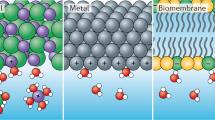Abstract
Interfaces form at the physical boundary between two phases, such as between a solid and a liquid (S/L), a liquid and its vapor (L/V), or a solid and a vapor (S/V). There can also be interfaces between two different solids (S1/S2) or between two immiscible liquids (L1/L2). This chapter will consider two special interfaces, the solution/air interface and the metal/solution interface. A brief discussion of the solution/air interface is useful in pointing out some general properties of interfaces. The metal/solution interface is, of course, of paramount interest to the study of corrosion.
Access this chapter
Tax calculation will be finalised at checkout
Purchases are for personal use only
Similar content being viewed by others
References
J. O’M. Bockris and A. K. N. Reddy, “Modern Electrochemistry”, Second Edition, Vol. 1, Chapter 2, Plenum Press, New York (1998). Also, First Edition, Vol. 1, Chapter 2 (1977).
A. W. Adamson, “Physical Chemistry of Surfaces”, p. 74, John Wiley, New York (1990).
J. O’M. Bockris and A. K. N. Reddy, “Modern Electrochemistry”, Vol. 2, Chapter 7, Plenum Press, New York (1977).
J. O’M. Bockris, M. A. V. Devanathan, and K. Müller, Proc. R. Soc., 274, 55 (1963).
E. McCafferty and N. Hackerman, J. Electrochem. Soc., 119, 146 (1972).
P. Vanysek in “CRC Handbook of Chemistry and Physics”, D. R. Lide, Ed., pp. 8−21, CRC Press, Boca Raton, FL (2001).
W. M. Latimer, “The Oxidation States of the Elements and Their Properties in Aqueous Solutions”, Prentice-Hall, New York (1952).
M. Pourbaix, “Atlas of Electrochemical Equilibria in Aqueous Solutions”, National Association of Corrosion Engineers, Houston, TX (1974).
A. J. Bard, R. Parsons, and J. Jordan, Eds., “Standard Potentials in Aqueous Solutions”, Marcel Dekker, New York (1985).
J. P. Hoare and S. Schuldiner. J. Phys. Chem., 61, 399 (1957).
M. H. Peterson and R. E. Groover, Mater. Prot. Perform., 11 (5), 19 (1972).
D. T. Sawyer and J. L. Roberts, Jr., “Experimental Electrochemistry for Chemists”, Chapter 2, Wiley Interscience, New York (1974).
H. H. Uhlig and R. W. Revie, “Corrosion and Corrosion Control”, Chapter 3, John Wiley, New York (1985).
D. G. Ives and G. J. Janz, Eds., “Reference Electrodes: Theory and Practice”, Chapter 2 and 3, Academic Press, New York (1961).
J. R. Myers, “Fundamentals and Forms of Corrosion”, Air Force Institute of Technology, Wright-Patterson Air Force Base, Ohio, October (1974).
S. Barnartt, J. Electrochem. Soc., 108, 102 (1961).
Author information
Authors and Affiliations
Rights and permissions
Copyright information
© 2010 Springer Science+Business Media, LLC
About this chapter
Cite this chapter
McCafferty, E. (2010). Charged Interfaces. In: Introduction to Corrosion Science. Springer, New York, NY. https://doi.org/10.1007/978-1-4419-0455-3_3
Download citation
DOI: https://doi.org/10.1007/978-1-4419-0455-3_3
Published:
Publisher Name: Springer, New York, NY
Print ISBN: 978-1-4419-0454-6
Online ISBN: 978-1-4419-0455-3
eBook Packages: Chemistry and Materials ScienceChemistry and Material Science (R0)




